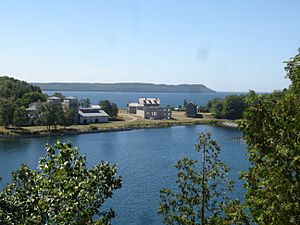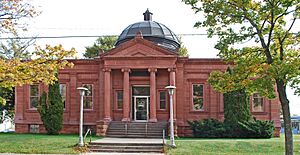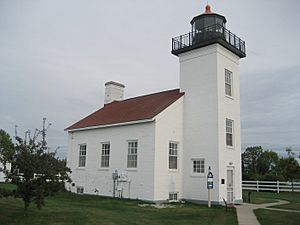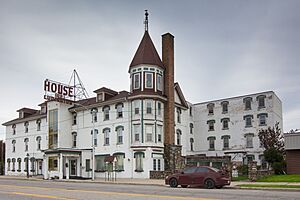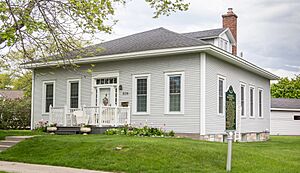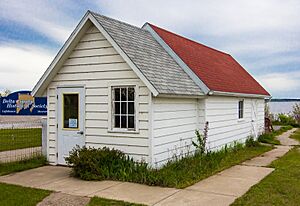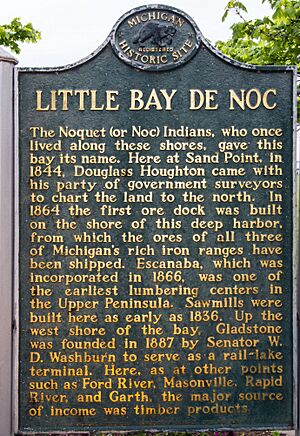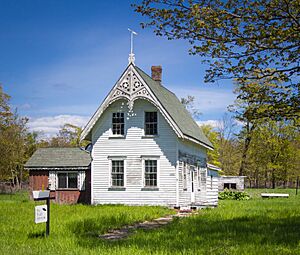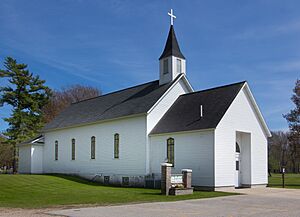List of Michigan State Historic Sites in Delta County facts for kids
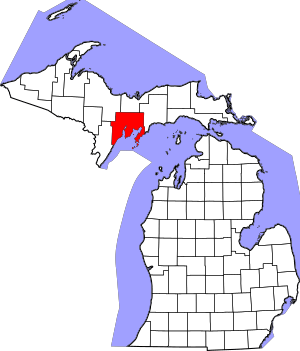
Welcome to Delta County, Michigan! This area is full of amazing places that tell stories about the past. These special spots are called Michigan State Historic Sites. They are important because they help us learn about the people, events, and buildings that shaped Michigan.
Some of these sites are so important that they are also listed on the National Register of Historic Places. You'll see a small cross symbol (†) next to their names if they are on that list too. Let's explore some of these cool historic places!
Contents
Discovering Delta County's Historic Sites
Delta County has many interesting places that have been marked as historic. These sites help us remember and understand the past. They include old buildings, important natural areas, and places where big events happened.
Fayette Historic State Park: A Ghost Town Story
One of the most exciting places is Fayette†. Imagine a whole town that used to be busy, but now it's quiet and preserved! Fayette was once a busy industrial town. It was built around an iron smelting operation. Here, iron ore was turned into pig iron. This happened from 1867 to 1891.
Today, you can walk through the old town. You can see the furnace complex, charcoal kilns, and many other buildings. It's like stepping back in time. The park is located on County Road #483, between Garden and Fairport. It was listed as a historic site on August 23, 1956.
Escanaba's Historic Buildings
The city of Escanaba has several important historic buildings. These buildings show us what life was like long ago.
Carnegie Public Library: A Place for Books
The Carnegie Public Library† is a beautiful old building. It was built with money from Andrew Carnegie. He was a famous businessman who helped build many libraries. This library has been a place for learning for a long time. It is located at 201 South 7th Street. It became a historic site on January 16, 1976.
Sand Point Lighthouse: Guiding Ships
The Sand Point Lighthouse† stands proudly on the shore. Lighthouses are like giant flashlights. They help guide ships safely. This lighthouse has a long history of helping sailors on Lake Michigan. It is found at 12 Waterplant Road. It was listed as a historic site on February 25, 1988.
Ludington Hotel: A Grand Old Place
The Ludington Hotel is another important building in Escanaba. Hotels like this were once very grand. They hosted travelers and important events. It is located at 223 Ludington Street. It became a historic site on February 23, 1981.
Charles Brotherton House: A Historic Home
The Charles Brotherton House is a historic home. It gives us a peek into how people lived in the past. It is located at 606 Ogden Avenue. It was listed as a historic site on October 12, 1990.
Squaw Point Boathouse: On the Water
The Squaw Point Boathouse is a unique building. Boathouses were used to store boats. This one shows us the importance of water travel and recreation. It is also located at 12 Waterplant Road. It became a historic site on October 12, 1990.
Informational Designations: Stories of the Land
Some historic sites are not buildings. They are places where important events happened or where nature played a big role. These are called "Informational Designations."
Grand Island Indian Trail: Ancient Paths
The Grand Island Indian Trail Informational Designation marks an old trail. Native Americans used trails like this for travel and trade. It reminds us of the first people who lived here. You can find it on US-2, just east of the Whitefish River in Rapid River. It was designated on May 4, 1966.
Escanaba River-The Legend: River Tales
The Escanaba River-The Legend Informational Designation tells a story about the Escanaba River. Rivers were vital for transportation and life. This site is at Pioneer Trail Park, on US-2 & -41 (M-35), about 1 mile north of Escanaba. It was designated on May 4, 1966.
Little Bay de Noc: A Beautiful Bay
Little Bay de Noc Informational Designation highlights this beautiful bay. Bays are important for fishing and shipping. This spot is at a Roadside City Park on Lake Shore Drive in Escanaba. It was designated on April 2, 1957.
Sawmills: The Lumber Story
The Sawmills Informational Designation reminds us of the lumber industry. Michigan was famous for its forests and sawmills. These mills turned trees into wood for building. This site is also at Pioneer Trail Park, on the Escanaba River, 1 mile north of Escanaba. It was designated on May 4, 1966.
Other Notable Historic Sites
Delta County has even more historic places that are important to its story.
Samuel Elliot Farm: Farming History
The Samuel Elliot Farm shows us the history of farming in the area. Farms were crucial for feeding communities. This farm is located at 13250 8th Rd. in Sac Bay. It was listed on November 14, 1974.
Maple Ridge Workers Association Hall: Community Gatherings
The Maple Ridge Workers Association Hall was a place for community meetings. It was important for people to gather and work together. It is located at 14398 M-35 in Rock. It became a historic site on July 26, 1978.
Saint Lawrence Catholic Church: A Place of Worship
The Saint Lawrence Catholic Church is a historic church. Churches have always been important centers for communities. This church is located at 8240 River in Nahma. It was listed on February 11, 1972.
Images for kids
See also


